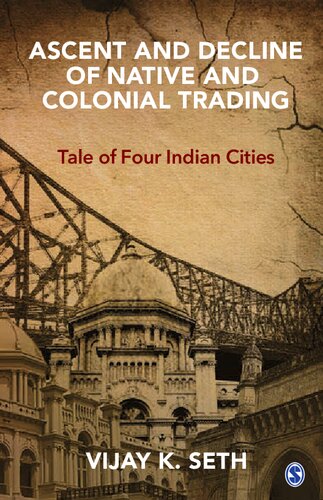In the present book, I have deliberately used their historical names rather than their contemporary names to put these cities in the con- text of their historical circumstances. I would also like to emphasize here that in both the set of cities, I have selected one native city and one colonial city. Both the native cities were centres of production of manufactured products by their traditional flexible manufacturing. These products had global demand. The colonial cities were established by the foreign trading company—the East India Company—as siblings of the native cities as trading bases to export the manufactured prod- ucts produced in the native cities. The objective of telling the story of these four cities is to explore the consequences of symbiotic existences between native cities and colonial cities. Native cities were embedded in the native economy and obtained all the elements for their sustenance from their linkages which they enjoyed with native economy. Colonial cities were generally port cities which had emerged as a consequence of the existence of a rudimentary form of globalization that had evolved after the trading links were established by European trading companies. These linkages emerged after the period of discovery, when sea route to India was discovered by Vasco da Gama in 1498. Initially, these cities were trading bases of European trading companies, but as the process of territorial occupa- tion began by these trading companies, these cities assumed the role of colonial cities. It is because spread of colonialism began from these port cities to the inland territories. The colonial cities were used as key devices by colonial power to establish their political and economic hegemony on the Indian subcontinent.
چکیده فارسی
در کتاب حاضر، من عمداً از نامهای تاریخی آنها به جای نامهای امروزی آنها استفاده کردهام تا این شهرها را در چارچوب شرایط تاریخی خود قرار دهم. اینجا هم تاکید می کنم که در هر دو مجموعه شهرها یک شهر بومی و یک شهر استعماری را انتخاب کرده ام. هر دو شهر بومی مراکز تولید محصولات تولیدی با تولید انعطاف پذیر سنتی خود بودند. این محصولات تقاضای جهانی داشتند. شهرهای استعماری توسط شرکت بازرگانی خارجی -شرکت هند شرقی- به عنوان برادر و برادر شهرهای بومی به عنوان پایگاه تجاری برای صادرات محصولات تولیدی تولید شده در شهرهای بومی تأسیس شدند. هدف از بیان داستان این چهار شهر، کشف پیامدهای وجود همزیستی بین شهرهای بومی و شهرهای استعماری است. شهرهای بومی در اقتصاد بومی گنجانده شده بودند و همه عناصر زندگی خود را از پیوندهایی که با اقتصاد بومی داشتند به دست می آوردند. شهرهای استعماری عموماً شهرهای بندری بودند که در نتیجه وجود شکل ابتدایی جهانیسازی که پس از ایجاد پیوندهای تجاری توسط شرکتهای تجاری اروپایی شکل گرفته بود، پدید آمدند. این پیوندها پس از دوره کشف، زمانی که مسیر دریایی به هند توسط واسکو داگاما در سال 1498 کشف شد، پدیدار شد. این شهرها نقش شهرهای استعماری را بر عهده گرفتند. به این دلیل است که گسترش استعمار از این شهرهای بندری به سرزمین های داخلی آغاز شد. شهرهای استعماری به عنوان ابزارهای کلیدی توسط قدرت استعماری برای ایجاد هژمونی سیاسی و اقتصادی خود در شبه قاره هند مورد استفاده قرار گرفتند.
ادامه ...
بستن ...
Author(s): Vijay K. Seth
Publisher: SAGE Publications, Year: 2019
ISBN: 9789353280840
ادامه ...
بستن ...










